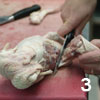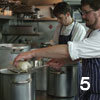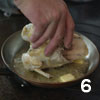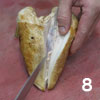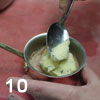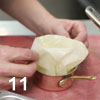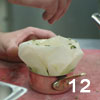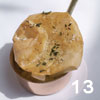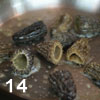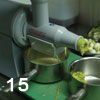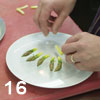Two-timing chicken
At Cambridge restaurant Midsummer House, part of the Crown Group, chef-patron Daniel Clifford calls his chicken dish a "pot roast". It isn't, though, the traditional pot roast, where a piece of meat or poultry is cooked in the oven in a sealed pan that is opened at the table in front of the customer.
Instead, he is twice-cooking the chicken: par-cooking it in a broth, then finishing it on the range and in the oven. The technique, popular in Chinese cookery for centuries, keeps the meat succulent. It has the extra advantage of letting the chef cook a chicken to order, effectively in less than 20 minutes.
His method suits the quality of chickens he uses, English-bred Label Anglais birds, which have a firmer texture, more body and more taste than standard Grade A poultry. The double-cooking principle would also work with duck, guinea fowl and some feathered game that is notoriously dry after oven-roasting
Daniel Clifford
"I'm here to cook," insists Daniel Clifford. The chef-patron of Midsummer House, Cambridge, Square Meal's Restaurant of the Year, says he doesn't want to become a cook who abandons his stove for other interests. In fact, he insists, he can't even work the pass during service, preferring instead to look after the meats, fish and sauces. Nor does he leave his kitchen to take time off, not even with his family. "I reckon that if people come here and pay £50 to eat, they expect my personal input, even though I've got chefs who can do the job."
At 31, he has already been cooking professionally for more than 16 years. His CV includes a stint working for David Cavalier when he was at the Bell, Aston Clinton, at the famous Box Tree, Ilkley, Rascasse in Leeds, and for Jean Bardet, a classic Michelin two-star at Tours in the Loire.
Clifford is much-travelled. He's taken his team of chefs on fact-finding tours to France and Spain - and names the restaurants of Juan Mari Arzak in San Sebastián, Spain, and Michel Bras at Laguiole in south-west France as his two favourites. His cooking style, though, is very much his own: carefully inventive, technically quite classic and almost obsessively interested in the fine detail of every element that goes into a dish.
Pot-roasted chicken with asparagus, morels and a truffled forcemeat
Recipe overview
Organising: Daniel Clifford has nine chefs, and four of them are involved in the service of his chicken pot roast.
Basic advance preparation: chicken stock, Madeira sauce, vegetable prep, forcemeat, chicken crowns.
During service: poaching and roasting chicken; assembling and baking the forcemeat and truffled purée with brick pastry; microwaving asparagus; sautéing morels; leeks and cream; finishing Madeira sauce; plating up.
Preparing the chicken (One 1.25kg oven-ready chicken (1) gives two "supreme" portions)
Start at the wings. Cut around the skin and through the flesh at the breast end of the wing. Pull them back to the wing joint, exposing the bone (2). Cut through the wing joint. Repeat with the second wing
Hold the leg away from the breast so that the skin is tense. Cut through the skin, leaving the skin covering the breast (3).
Pull back the leg against the joint so that the bone comes out of the socket.
Free the leg from the carcass, using the tip of a sharp knife. Repeat with the second leg.
Expose the wishbone. Scrape round the inside of it with a sharp knife. Loosen it and pull it out (4).
Without cutting into the breast meat, cut through the rib cage on both sides of the chicken. Snap the backbone and remove it, so you are left with a classic poultry "crown".
Use all the trimmings from the chicken except for the parson's nose to make chicken stock.
Poaching the chicken crown Use a light, white, unseasoned, unreduced chicken stock flavoured only with thyme and a little bay leaf. The quantity doesn't matter so long as the chicken can be submerged completely in it for poaching.
At Midsummer House the stockpot contains about eight litres, which is kept at simmering point, 80°C, throughout service.
Drop the chicken crown into the stock (5) and simmer for eight minutes only. Drain, and rub salt into the skin.
Roasting Preheat the oven to 200°C.
Heat 2tbs sunflower oil and 15g butter in a pan until it's sizzling.
Sear the chicken crown on all sides until the skin starts to colour (6). Transfer to the oven. Roast for 10 minutes.
Take out of the oven and baste thoroughly while the fat is still foaming (7). Rest 5-10 minutes before carving the breasts off the carcass (8).
Finalising the dish
Ingredients
(Serves one)
1 chicken breast, poached and
roasted
1 serving mushroom purée
50-60g leeks with créme fraîche
1 serving asparagus
1 serving morels
2-3tbs Madeira sauce
1 copper pan of forcemeat, truffle
potato and brick pastry
Method
Carve the chicken breast off the bone as a single supreme. Trim any loose bits so it has a neat, streamlined shape.
Arrange two spoons of mushroom purée to one side of the plate and pull a knife through them so they look stylish.
Place the leeks near the centre of the plate and put the chicken on top (9). Lay the asparagus and morels around them.
Spoon the sauce over the chicken and vegetables.
Serve the forcemeat accompaniment separately.
Forcemeat accompaniment The forcemeat is used in canapés and is a part of the standard mise en place. When making up the accompaniment allow about 120g cooked forcemeat per portion.
Ingredients
1kg chicken legs
500g veal sweetbreads
500g foie gras
500g chicken livers
500g smoked streaky bacon
Sunflower oil
300g butter
6 large onions, sliced
4 cloves garlic
Salt and pepper
Method
Remove the sinews from the legs and hand-chop the meat into small dice.
Soak the sweetbreads in water to remove any traces of blood. Blanch for two minutes in boiling water. Refresh and remove any fat and sinews.
Open up the foie gras and remove arteries and veins. Cut out any stringy bits from the chicken livers.
Dice the smoked bacon.
In separate pans, using as little oil as possible, sauté the meats in sunflower oil until just cooked. Chill and reserve.
Melt the butter in a saucepan. Add the onions and garlic. Cook very gently on the side of the stove for three hours, until the onions are sticky and "confit". Chill.
Put the meats and onions through the mincer (fine blade) to obtain a kind of pâté. Check the seasoning.
Vacuum-pack in 1kg batches.
Mashed potato
Ingredients
(About 120g per portion)
1kg Desirée potatoes, freshly boiled
300g slightly salted butter
Salt and white pepper
About 5tbs diced black truffle
Method
Pass the potato through a ricer. Beat in the butter. Season.
Add the truffle only when preparing individual portions to prevent loss of aroma.
Brick pastry lid
Ingredients
1 sheet brick paste per portion
Melted butter
Pinch fresh thyme leaves
Maldon salt or fleur de sel
Pepper
For method, see assembly.
Assembly per portion
Forcemeat - mashed potato - one slice truffle - brick pastry
Preheat the oven to 200°C. Spread a portion of forcemeat over the base of a 500ml copper pan or soufflé dish. Cover with a layer of truffled mash (10). Lay a slice of truffle on top.
Pull the corners of the pastry together to form a kind of pocket. Fit it into the pan so it looks like a chef's hat (11). Brush with butter. Sprinkle with thyme, salt and pepper (12). Bake until golden (13), about five minutes. Keep hot at 140°C.
Vegetables
- Mushroom purée Midsummer House makes this in a large batch. Allow two heaped tablespoons per portion.
- Asparagus tips five asparagus spears per portion
- Morels 5-6 morels per portion
- Blanched leeks 40-50g per portion
Ingredients
For the mushroom purée
6kg mushrooms, roughly chopped
Oil or clarified butter
12 shallots, sliced
12 garlic cloves
Thyme and bay leaves
1 litre vegetable stock
300ml Madeira
Salt and pepper
1tbs whipping cream per serving
1tsp white truffle oil per serving
Method
Mushroom purée: sauté the mushrooms in very hot oil, so they colour quickly (14). Continue cooking till they start to render their juices. Strain off the liquid, but reserve it. Add the shallots and garlic to the pan and cook them out with the mushrooms. Add the stock and simmer until well reduced. Flavour the mushrooms with Madeira. Season. Add back the reserved juice. Liquidise the mushrooms and pass through a tamis.
To finish the purée, reheat 2tbs purée with 1tbs cream and finish with truffle oil. It should hold its shape when spooned on to the plate.
Asparagus tips: put the stringy pared outsides of the asparagus and the bottoms through a juicer (15). Retain the juice. Cover a plate with clingfilm. Lay the halved asparagus tips on it (16). Spoon one tablespoon of juice over them. Season. Cover with a second layer of film. Microwave at maximum power (1.5kW) for 22-30 seconds.
Morels: trim the morels, sautÄ in butter and season.
Blanched leeks: cut the whites of leeks to the size of small postage stamps. Blanch in boiling water until just cooked (about a minute). Drain and pat dry. Reheat with créme fraîche, but don't boil
Maderia sauce
Sauce base (about 40 portions)
Put four chopped sticks of celery, two shallots, nine cloves garlic, a scant kilogram of mushrooms and one teaspoon black peppercorns in a roasting tin. Coat them well in two tablespoons of oil. Roast until coloured. Deglaze with one bottle of dried white wine. Reduce by half. Simmer in a large pan with four litres of brown veal stock, two bottles of Madeira, ¼ bunch of tarragon, ½ bunch thyme, four bay leaves and two heaped tablespoons of powdered dried cèpes (porcini). Simmer until the flavours are well concentrated (about 30 minutes). Pass seven times through a tamis or fine sieve. Boil and check the seasoning.
Finalising sauce
To finish the sauce, Daniel Clifford prepares a separate Madeira reduction - three bottles reduced to 500ml - which he keeps in a squeezy bottle.
Per portion
Heat 60-70ml of the sauce base. Stir in a tablespoon of whipping cream and a squeeze of Madeira reduction.
Label Anglais chicken Until recently, the quality of UK poultry was such that few of the top restaurants would put it on their menus. The argument was that whether it came from a free-range, deep-litter or broiler-house environment it was too rapidly grown, had little flavour and a soft, uninteresting texture. On the other hand, French poulet de Bresse was prohibitively expensive when imported to the UK.
Fortunately, the situation is improving, and chefs can find slow-grown, genuine free-range chickens providing that they are prepared to take a little trouble to source them.
Daniel Clifford buys his from SJ Frederick & Sons, in Harlow, Essex, a company that breeds Label Anglais, a Red Cornish/White Rock cross that's slaughtered at about 12 weeks old.
www.labelanglais.co.uk





